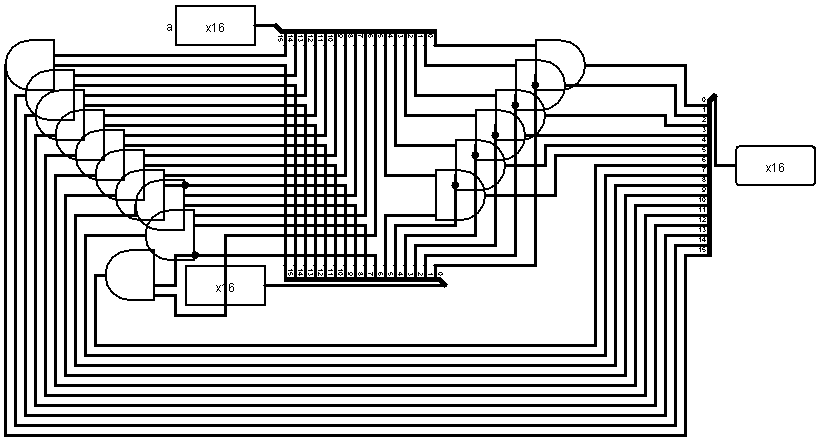And16 Chip
1. And16 Chip
The And16 chip performs a bitwise AND operation on two 16-bit inputs (a and b), producing a 16-bit output (out).
Each output bit out[i] is the result of a[i] AND b[i] (for i = 0..15).
This is a parallel operation—all 16 bits are processed simultaneously.
2. Truth Table
| a[0] | b[0] | out[0] | a[1] | b[1] | out[1] | ... | a[15] | b[15] | out[15] |
|------|------|--------|------|------|--------|-----|-------|-------|---------|
| 0 | 0 | 0 | 0 | 0 | 0 | ... | 0 | 0 | 0 |
| 0 | 1 | 0 | 0 | 1 | 0 | ... | 0 | 1 | 0 |
| 1 | 0 | 0 | 1 | 0 | 0 | ... | 1 | 0 | 0 |
| 1 | 1 | 1 | 1 | 1 | 1 | ... | 1 | 1 | 1 |
Example:
If a = 0b1100 and b = 0b1010 (4-bit simplification), then out = 0b1000.
Extend this logic to 16 bits.
2. Implementation (Logisim)
Representation of the And16 Chip in the logisim software using the previous gates.
Built using 16 individual AND gates, each processing one bit of the input buses.

3. Implementation (HDL)
Representation of the And16 Chip in HDL using previous gates.
CHIP And16 {
IN a[16], b[16];
OUT out[16];
PARTS:
And(a=a[0], b=b[0], out=out[0]);
And(a=a[1], b=b[1], out=out[1]);
And(a=a[2], b=b[2], out=out[2]);
And(a=a[3], b=b[3], out=out[3]);
And(a=a[4], b=b[4], out=out[4]);
And(a=a[5], b=b[5], out=out[5]);
And(a=a[6], b=b[6], out=out[6]);
And(a=a[7], b=b[7], out=out[7]);
And(a=a[8], b=b[8], out=out[8]);
And(a=a[9], b=b[9], out=out[9]);
And(a=a[10], b=b[10], out=out[10]);
And(a=a[11], b=b[11], out=out[11]);
And(a=a[12], b=b[12], out=out[12]);
And(a=a[13], b=b[13], out=out[13]);
And(a=a[14], b=b[14], out=out[14]);
And(a=a[15], b=b[15], out=out[15]);
}